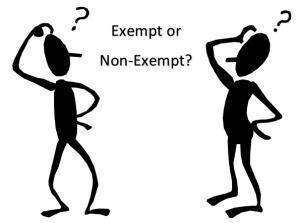STRATEGIES TO COMPLY WITH THE NEW OVERTIME RULES
 The biggest overhaul of the overtime laws in U.S. history takes effect in approximately 10 weeks. Starting Dec. 1, the minimum annual salary for employees to be considered exempt from the Fair Labor Standards Act’s (FLSA) overtime regulations will increase to $47,476 or $913 per week up from $23,660 or $455 per week. Employee positions are classified as either “nonexempt” or “exempt”. Nonexempt employees are entitled to overtime pay. Exempt employees are not.
The biggest overhaul of the overtime laws in U.S. history takes effect in approximately 10 weeks. Starting Dec. 1, the minimum annual salary for employees to be considered exempt from the Fair Labor Standards Act’s (FLSA) overtime regulations will increase to $47,476 or $913 per week up from $23,660 or $455 per week. Employee positions are classified as either “nonexempt” or “exempt”. Nonexempt employees are entitled to overtime pay. Exempt employees are not.
According to the Department of Labor, the new overtime law will automatically extend eligibility for overtime pay to over 4 million workers and cost private employers $1.8 billion in the first year the law is implemented. Companies expected to be hit the hardest by changes in the law are retail shops, restaurants, call centers, nonprofits and small businesses.Three tests must be met for an employer to claim an overtime exemption.
Determining that an employee is exempt from the FLSA’s minimum wage and overtime requirements involves assessing three tests.
1. Salary Basis Test – how the employee is paid (salary or hourly);
2. Salary Level Test – how much the employee earns (increases to a minimum annual salary of $47,476 on Dec 1); and the
3. Duties Test – whether the employee primarily performs the kind of job duties excluded from the law’s overtime protections as described under the executive, administrative, or professional classifications in the FLSA.
Many organizations are struggling to figure out how to implement the new law. The biggest misunderstanding by employers is they feel the only way to comply with the new overtime pay rules is to change current exempt employees who earn less than $47,476 per year from salaried workers to hourly employees. But employers also have other options such as:
• Raise the worker’s salary and keep the employee exempt from overtime. Employers can choose to raise the salaries of employees to at or above the new salary level of $47,476 to maintain their exempt status, if those employees meet the duties test of an executive, administrative or professional employee. This option works for employees who have salaries close to the new salary level and regularly work overtime. With this option an employer can also include up to 10% of nondiscretionary bonuses and incentive payments (including commissions) paid to employees to help satisfy the salary threshold.
• Pay overtime in addition to the employee’s current salary when necessary: Employers may continue to pay their previously exempt employees the same salary and pay them overtime whenever they work more than 40 hours in a week. This approach works for employees who work 40 hours or fewer in a typical workweek, but have occasional spikes that require overtime for which employers can plan and budget the extra pay during those periods. Remember, there is no requirement to convert employees from salaried to hourly workers in order to calculate their overtime pay. The employer must record and keep track of the hours worked by the employee.
• Evaluate and realign hours and staff workloads. Employers can ensure that workload distribution, time and staffing levels are all managed appropriately for their white-collar workers who earn below the new exempt salary threshold. Employers can consider hiring additional workers or temporary staff when needed.
• Adjust wages. Employers can adjust the amount of an employee’s earnings to reallocate it between regular wages and overtime so that the total amount paid to the employee remains largely the same. The employee must, however, continue to receive the highest minimum wage under federal and state laws.
• All of the above. Employers can implement a combination of all of the above options.
Remember, job titles never determine exempt status under the FLSA nor does receiving a particular salary, alone indicate that an employee is exempt from overtime and minimum wage protections. In order for a white-collar exemption to apply, an employees’ specific job duties and earnings must meet all of the applicable requirements provided in the regulations.
Don’t get caught “flat footed” on December 1; if you need assistance in analyzing and developing a plan to implement the new overtime rules at your company give our office a call at (414) 871-2770.
COULD THIS BE YOUR SITUATION?
Recent Case
 While working as a manufacturing engineer for Dril-Quip, Ronald was paid between $72,500 and $88,500 per year on a weekly salary basis. He did not have a college degree and only completed one year of higher education. His job was to manage the manufacturing process for specific products so they were produced according to sales for that week.
While working as a manufacturing engineer for Dril-Quip, Ronald was paid between $72,500 and $88,500 per year on a weekly salary basis. He did not have a college degree and only completed one year of higher education. His job was to manage the manufacturing process for specific products so they were produced according to sales for that week.
Ronald sued his employer alleging that he was wrongly classified as an exempt employee and should have earned overtime for all hours beyond 40 that he worked.
Dril-Quip argued he was an exempt administrative employee. Ronald argued that his job required no discretion or exercise of judgement and that he merely followed guidelines. His employer disagreed.
The court said that the case should go to trial so a jury can decide whether he was exempt or an hourly employee entitled to overtime. His high salary alone did not determine his status. (Elliot vs. Dril-Quip, No. H-14-1743, SD TX, 2015).
Final Thought
Although Ronald’s title was Engineer, he held no degree. That precluded his classification as an exempt professional employee. Remember, what you call an employee isn’t important. What matters is what the employee actually does. Don’t make the mistake of thinking that just because an employee is paid a salary, he or she is exempt. The employer must also show that the worker performed exempt work under one of the several exemptions available under the FLSA. Failure to properly classify employees can result in penalties and fines from the Department of Labor (DOL). If you need help to properly classify your employees, please give our office a call at (414) 871-2770.
YOUR QUESTIONS…OUR ANSWERS
Can Employees Bank Overtime Hours and Take Time Off Later?
Question: Sometimes, our employees work overtime and we note those hours in an overtime bank so they can take time off later. One of our nonexempt employees claims this is illegal and that we have to pay him. Is that true?
Answer: It sounds as if you have created an informal comp time program. If you are a private employer as opposed to a governmental agency, then it is not permissible to provide this “overtime bank” in lieu of paying overtime to nonexempt employees when they work more than 40 hours in a week. Employees who are nonexempt must be paid time-and-a-half for any hours worked in excess of 40 in any workweek. You cannot provide an informal or formal IOU voucher for excess hours worked.
Can Overtime Hours Worked Be Spread Over a Pay Period?
Question: Our employees are paid on a bi-weekly basis. Can we lump together the total hours worked in those two weeks when determining overtime for nonexempt employees?
Answer: No. You must distinguish the number of hours worked each week because overtime is always calculated on a weekly basis for all hours worked over 40. You can’t eliminate overtime hours by averaging hours in two work weeks. Example: An employee who works 50 hours in one week and 30 hours in the next must be paid for 10 overtime hours for the first week. Averaging the two weeks to come up with 40 hours per week (i.e. no overtime) violates the FLSA.
Note: If your business needs an overtime policy or would like a training session on who is an exempt and nonexempt employee, please give our office a call at (414) 871-2770.
OVERTIME IS MONEY
 The FLSA requires employers to keep accurate records of hours worked and wages paid to nonexempt employees. However, they do not require that employers use any particular method for timekeeping. Because employers are required to pay employees for all hours worked whether authorized or not, they should use an efficient reliable timekeeping system that can serve as the basis in defense of a wage-and-hour lawsuit should an employee file a claim. In instances where employers have failed to keep good records of hours worked by employees, the courts have taken the word of the employee. That can be very costly to a business. Employers can be liable for two years’ worth of back wages, or three years of back wages if the violation is willful. In 2015, the DOL collected $246 million in back wages for 240,000 workers.
The FLSA requires employers to keep accurate records of hours worked and wages paid to nonexempt employees. However, they do not require that employers use any particular method for timekeeping. Because employers are required to pay employees for all hours worked whether authorized or not, they should use an efficient reliable timekeeping system that can serve as the basis in defense of a wage-and-hour lawsuit should an employee file a claim. In instances where employers have failed to keep good records of hours worked by employees, the courts have taken the word of the employee. That can be very costly to a business. Employers can be liable for two years’ worth of back wages, or three years of back wages if the violation is willful. In 2015, the DOL collected $246 million in back wages for 240,000 workers.
Manual timekeeping systems such as paper timesheets or timecards tend to be inefficient, costly and inaccurate when processing payroll. We recommend employers implement an automated timekeeping solution where managers can effectively monitor the hours worked by employees throughout the pay period and easily detect when an employee is approaching overtime.
All businesses should have an overtime policy that nonexempt employees acknowledge receiving and is enforced by the organization’s supervisors and managers when violations occur. The combination of an automated timekeeping solution with customized work rules and a well written overtime policy should help protect your business from frivolous overtime lawsuits and “out of control” payrolls each pay period. If your company needs an affordable reliable state-of-the-art automated timekeeping system or an overtime policy, please give our office a call at (414) 871-2770.
